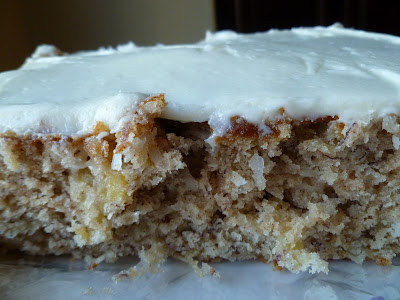I'm always on the lookout for good chocolate cake recipes. I want something moist throughout, including the edges, with a deep dark chocolate flavor that can be complemented by a good fudge frosting or contrasted with a vanilla or caramel frosting or glaze. Whenever I try to make a standard 8 or 9" layer cake, I'm always just slightly dissatisfied with the results. Either the taste is good but the texture is too light or too dense or the texture is perfect but the taste wasn't anything special. Or I can get both taste and texture but the cake as a whole is too delicate to successfully frost, slice and present. Something goes wrong.
So that's my long lead in to say this cake recipe is awesome! It makes up for the Baked Fudge Pudding debacle. Tish Boyle - and I say her name with the same reverence I say "Rose Levy Berenbaum" and "Lisa Yockelson" - does it again with a fantastic chocolate cake. I loved the dark chocolate taste of this cake and the texture was moist and cakey but not too light or too dense. I didn't glaze with the Bittersweet Chocolate Glaze that she recommended but instead made up my own Kahlua glaze with Kahlua, confectioners' sugar and a little milk. My glaze didn't turn out very pretty but I preferred something less chocolaty to complement the chocolate cake. There was just enough batter to fill 3 Bundt-lette pans so I haven't made this as a layer cake yet but I think it would be a good candidate for one the next time I do want to make a chocolate layer cake.
The other reason I really like this book is besides having fantastic recipes that are easy and straightforward to make, she includes weight measurements along with volume measurements. Weight measurements are more accurate than volume measurements, especially with dry ingredients. If you don't have a digital food scale, I recommend getting one for the best baking results.
½ cup (1.6 ozs/46 g) Dutch-processed cocoa powder
1 teaspoon baking powder
¼ teaspoon salt
¾ cup (1 ½ sticks/6 ozs/170 g) unsalted butter, softened
1 ¼ cups (8.8 ozs/250 g) granulated sugar
2 large eggs
¾ cup buttermilk
2 tablespoons Kahlua, optional
1 teaspoon vanilla extract
4 ounces (113 g) bittersweet chocolate, finely chopped, or ¾ cup miniature semisweet chocolate morsels
Bittersweet Chocolate Glaze
6 ounces bittersweet chocolate, coarsely chopped
3 cups heavy cream
1 teaspoon vanilla extract
1. Position a rack in the center of the oven and preheat oven to 350⁰F. Generously grease the molds of a 6-cake Bundtlette pan. Dust the molds with flour.
2. Sift together the flour, cocoa powder, baking powder and salt into a medium bowl. Whisk to combine, and set aside.
3. In the bowl of an electric mixer, using the paddle attachment, beat the butter at medium speed until very creamy, about 2 minutes. Gradually beat in the sugar, increase the speed to medium-high, and beat until the mixture is well blended and light, about 3 minutes. At medium speed, beat in the eggs one at a time, mixing well after each addition and scraping down the sides of the bowl as necessary.
4. In a small bowl, stir together the buttermilk, Kahlua (if using), and vanilla extract. At low speed, add the dry ingredients to the butter mixture in three additions, alternating with the buttermilk mixture in two additions and mixing just until blended. Remove the bowl from the mixer stand and stir in the finely chopped chocolate or semisweet morsels. Scrape the batter into the prepared cake molds, dividing it evenly and smoothing the tops.
5. Bake the cakes for 25 to 30 minutes, until a cake tester inserted into the center of a cake comes out clean. Cool the cakes in the pan on a wire rack for 10 minutes.
6. Invert the cakes onto the rack and cool completely.
7. Make the glaze: Place the chocolate in the bowl of a food processor and process just until finely ground.
8. In a small processor, bring the cream to a boil. Remove from the heat and add the chocolate to the pan. Stir until the chocolate is completely melted and the glaze is smooth. Stir in the vanilla extract. Transfer the glaze to a small bowl. Cover the surface of the glaze with a piece of plastic wrap and let cool for about 10 minutes before using.






















